Reviews & Articles
Shenzhen's MOCAPE: Potential Unfulfilled
John BATTEN
at 7:26pm on 19th December 2017
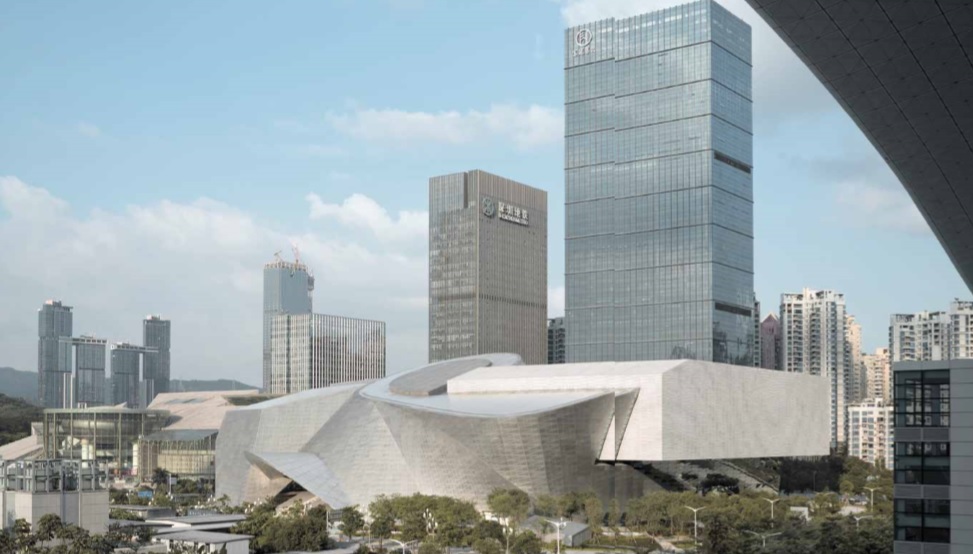
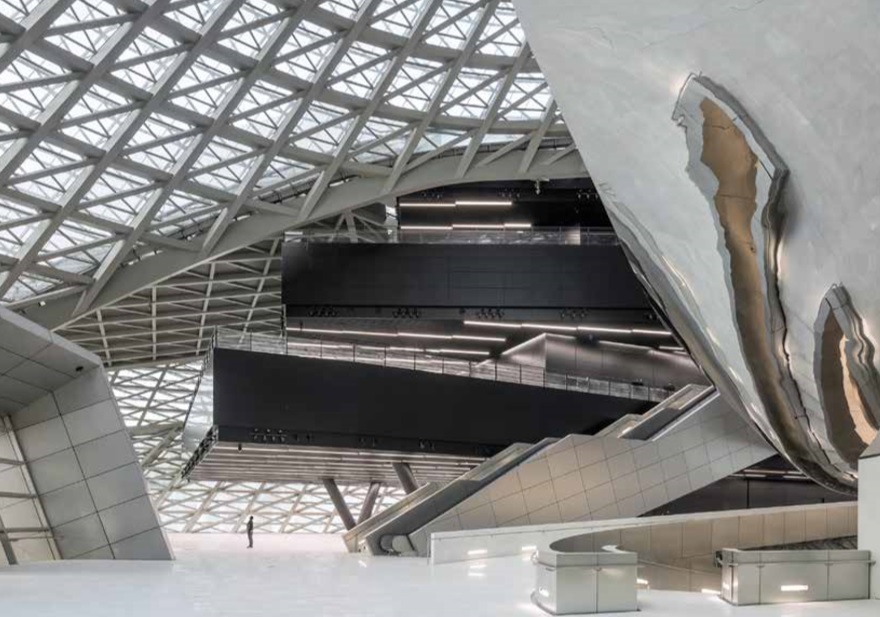
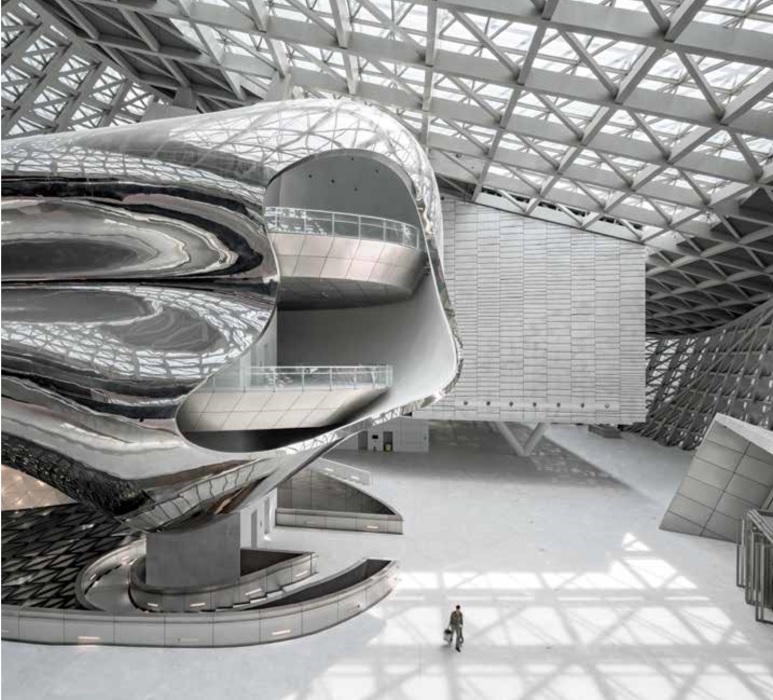
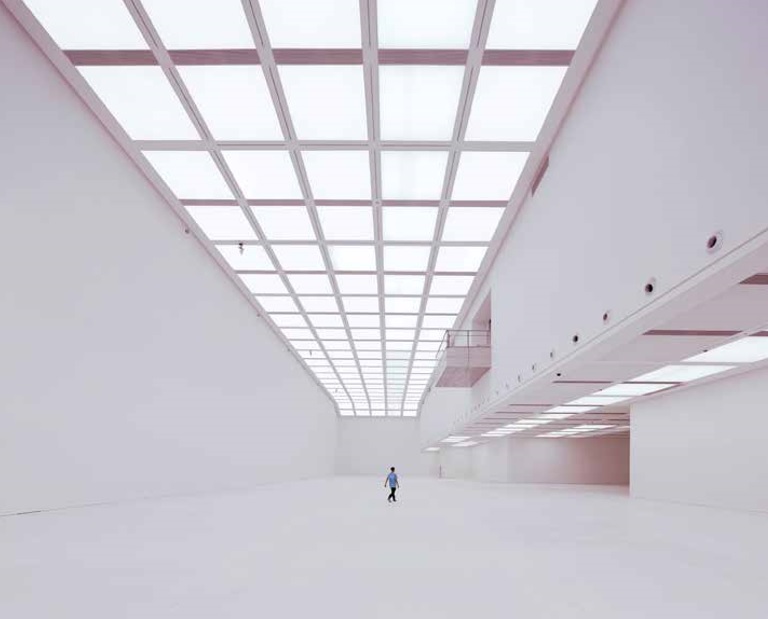
Captions:
1. The building’s exterior reflects its prestigious location next to major municipal facilities
2. The double-skin glass and steel roof draws light deep into the public areas
3. The stainlesssteel ‘dolphin’ is designed following feng shui principles
4. The exhibition spaces are vast and column-free – one hall stretches for 90m
© Photography by Duccio Malagamba
(原文以英文發表,題為〈深圳當代藝術博物館與城市規劃展覽館: 潛力未盡現〉。)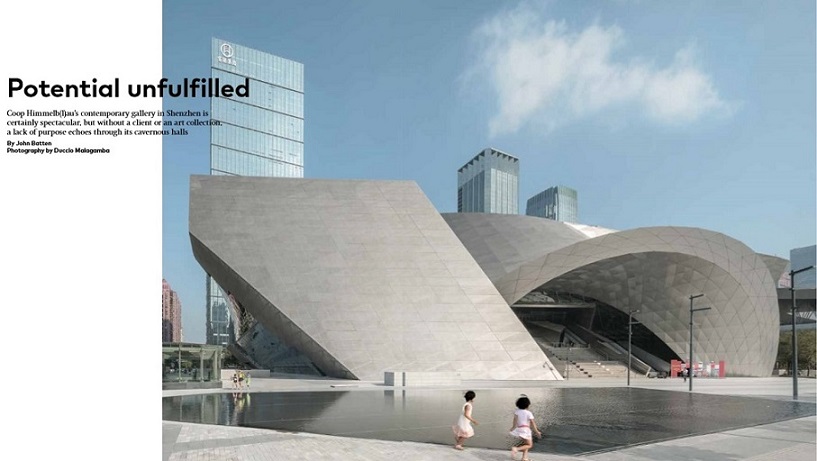
Shenzhen was for a time an imagined city, as were Brasília and Canberra. Unlike those two planned cities of government, Shenzhen’s raison d’être was trade with the ‘outside world’. Designated China’s first Special Economic Zone in 1980, Shenzhen was picked to be a capitalist oasis, surrounded by China’s state-led command economy, but purposely located next to Hong Kong. In those early days Hong Kong entrepreneurs provided the capital, knowhow and worldwide trade connections to build factories and low-cost worker dormitories to jumpstart Shenzhen’s fledgling economy and spearhead China’s.
Cited as the country’s Silicon Valley, the city has evolved from an industrial hub to a city of logistics, finance, high-tech, design and creative industries and support services, with a population of 11 million. Rising to its own aspirations, Shenzhen has built upwards and encouraged both greater municipal planning and statement architecture. The Shenzhen Concert Hall and the nearby Shenzhen Civic Centre, colloquially known as the ‘Eagle’ thanks to its long undulating roofline, are in close proximity to OMA’s compelling Shenzhen Stock Exchange building. Located behind the Civic Centre is the recently completed Museum of Contemporary Art and Planning Exhibition (Mocape), designed by Austrian practice Coop Himmelb(l)au.
In 2007, Coop Himmelb(l)au won a competition for a contemporary art and urban planning centre for the Shenzhen government with a design that comprised two separate but linked buildings, reflecting the centre’s two functions. In 2008, following detailed discussions between the architect and city officials, the two-building design was replaced in favour of a single building after city officials visited the practice’s Dalian International Conference Center in northern China, then under construction. The final exterior design for Mocape now follows similar form, lines and materials to those employed at Dalian.
Around the same time, the Shenzhen authorities undertook a separate deal with a property developer, transferring a large government-owned residential site on the condition that the developer fully funded and oversaw the construction of Mocape. As a result, although it was technically built for the Shenzhen Municipal Culture Bureau, once the design had been agreed the property developer became the ‘client’ for the project’s entire construction phase.
This has led to some challenges. The property developer has no expertise in the operation of a contemporary art museum. Also, the long-term management of Mocape is still under negotiation – the current deal has the developer operating the building, despite its wish to relinquish this role. In short, Mocape was designed with a client that may not manage the building, and with no involvement from a dedicated, experienced curatorial art team able to advise on a design brief, exhibition needs or the building’s facilities and fabric. Consequently, the building has a composite design, rather than asserting Mocape’s future requirements.
Externally, complementary panels of matt-grey steel, steel gauze and mirrored glass wrap the building. The rear and one side have angular elevations, while an oblong volume contrasts with the elliptical arched front that encloses the main staircase, escalators and a small tiered seating area. This arched form is sculpted upwards and sideways along the other side elevation, giving the building – from a distance – a tunnel effect. Parts of both exterior and roof are enveloped by a double skin of glass and steel, allowing natural light to filter throughout the public areas. Intended as a defining architectural detail, this merges into the background once inside as a plethora of other spaces and forms jostle vigorously for attention.
The huge, marble-floored, column-free main atrium sets the tone. Located on the third floor, it is reached via the main external entrance or a discreet groundfloor entrance and internal spiral central staircase and escalators. The atrium is defined by an amorphous, polished stainless-steel form dividing the entire space in half. This focal point is referred to by the architect as a ‘cloud’, but intentionally resembles a dolphin, albeit without a pronounced nose – a nod to feng shui that proscribes sharp points. On the right are contemporary art exhibition spaces, identified by cream granite facades, and on the left the urban planning exhibition spaces are housed beneath black panelling – the contrasting colours approximate yin/yang symbolism. The atrium is a successful transition point in which the visitor can orientate themselves, with excellent sightlines upwards and to the rear of the building. Running through and around the dolphin is an elevator and staircase giving access to each floor, with good views over Shenzhen, and down towards Book City, China’s biggest book store.
An elevated bridge provides a sense of scale and leads from the dolphin towards the two passages giving access to each side of the building, emphasising Mocape’s dual uses. But these wide expanses of public circulation do beg a question: what happens in these huge open spaces?
The answer that is applied to almost all of Mocape’s interior seems to be ‘flexibility’ – small and large public areas, with their open layouts, are intended to host variously configured talks, gatherings, projections, installations, pop-up shops and exhibitions, as well as providing lounge seating and pedestrian circulation. Likewise, the various display spaces are flexible, large and column-free. In some, annoying air-conditioning vents and floor-embedded direction lighting are fitted to meet building and safety codes, but these are the only interruptions to the clean lines. In total, Mocape stretches across 80,000sq m over seven storeys. One hall is an unrelenting 90m x 35m x 15m.
The logic of these huge, clean halls is apparent. In the absence of a curatorial end-user, the developer and architects have opted for facilities more appropriate to a convention and trade centre. Future adjustments, especially to wall fittings and lighting, should still allow it to become what it purports to be. Undeniably, Mocape is enigmatic, and has great internal presence and an exterior that reflects it prestigious location next to major municipal facilities. Yet the fact remains that Shenzhen’s city government has no permanent art collection, no art team and, at this stage, no public funding for future operations. Having built an architecturally impressive building it will now, for the interim, lie idle.
This is not uncommon in China. The huge and excellent Shenzhen Stock Exchange is in a similar state. It may have great street presence, but little happens inside. There is no physical trading floor, as trades are done electronically; the multiple reception halls are rarely used. Mocape has been built with a similar mindset, serving as a symbol of Shenzhen’s – and by implication, China’s – progress, abundance and ambition. Its immediate future is unclear, but one imagines that investing in Mocape’s future will, at some point, be seen as a necessity by Shenzhen’s ambitious government officials. With tweaking of its interior facilities, the building could then be the impressive, functioning building it aspires to be.
This article was originally published in ICON architectural magazine (London, UK), May 2017.
原文刊於ICON 建築雜誌 (英國 倫敦) , 2017年5月。
|
|
|
|
|
|
